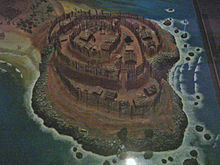New Zealand History/Maori Lifestyle
‹ Back to Polynesian Settlement of New Zealand
Maori Culture and Lifestyle up to 1840
[edit | edit source]Polynesians had arrived in Aotearoa (the Land of the Long White Cloud) i.e. New Zealand, around 1250 AD. At that point, having come from a tropical region, they had to dramatically change their lifestyle to suit the new environment.

Some of the biggest changes the Polynesians had to adapt to was that New Zealand was much larger and had a more temperate climate than the islands they had migrated from. This meant they had to build houses on the ground instead of on stilts to make them warmer, they had to develop much warmer clothing. New ways to hunt, fish, build, adapt. The Polynesians became a new group of people who eventually were called Maori (by Europeans) although 'Maori' referred to themselves as 'Tangata Whenua' i.e. People of the Land.
Maori as a people were known amongst themselves by their Iwi (Tribal) affiliations which often reflected the particular 'Waka' (or canoe) the individual could trace his oral history or lineage back to. Inter-marriage between Iwi was a way of strengthening alliances between various tribal groupings. Within Iwi (tribal groups) smaller family groups or sub-tribes (Hapu) was organized. Men had full faced tattoos (moko) which reflected this identity, as well as other attributes, such as status, bravery etc. Women also had tattooing on lower-lips and chins which also represented both lineage 'whakapapa', and status. This art of tattooing was highly sacred (Tapu), as were many other aspects of Maori culture such as canoe building, carving, hunting etc.
The first Maori settlements were mostly located around harbours or river mouths where fish and seabirds lived.
New Zealand, unlike their original islands, was abundant in wild game, so the Maori used both agriculture and hunting to sustain the Iwi. One of their biggest sources of food was the Moa, a large flightless bird. The Moas varied in size from the height of a turkey to 3.7 metres high. Unfortunately, this made them easy targets, and they became extinct due to over-hunting by about 1500. As a result of this, the Maori switched back to agriculture.

Gradually, the Maori dispersed themselves over New Zealand in different tribes, with different chiefs as leaders. The different tribes became more aggressive, however, and inter-tribal warfare became much more frequent over time. This led to the advent of the Pa (a fortified village). An average Pa included ditches, banks and Palisades as protection.
New Zealand eventually became divided up by tribal territories which were recognised by other tribes with predominant land features (rivers, mountains, lakes). This culture remained up until the 18th Century when the Europeans came to New Zealand.
After the first European whalers and traders came to New Zealand, the Maori lifestyle in some areas changed dramatically, and never returned to the way it was. One of the most popular commodities the Maori were interested in trading for were muskets. As Maoris had no long-range weapons, muskets were a valuable asset to tribes. The introduction of muskets made inter-tribal wars far more dangerous, especially if it was a tribe with muskets against a tribe without.
Before the arrival of Missionaries, Maori culture included their own religion, but when Europeans arrived that all changed, and Maoris were gradually converted to Christianity.
A written form of the Maori language was also created for the Maori by the Missionaries, and gradually the Maori culture became something completely different than before.
Forward to First European Explorers to Discover New Zealand ›
